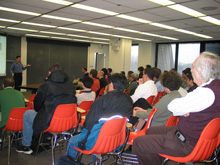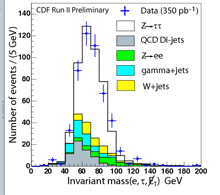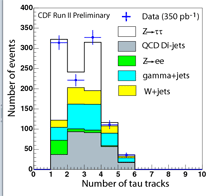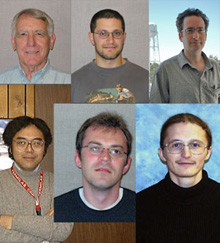 | Thursday, January 12, 2006 |
|
Thursday, January 12 |
|
Extended Forecast |
Secon Level 3 |
|
Thursday, January 12 -Minnesota Wild Rice w/Chicken -Tuna Melt on Nine Grain -BBQ Ribs -Chicken Casserole -Buffalo Chicken Wrap -Mexican Pizza -Chicken Pecan Salad |
|
Thursday, January 12
Wednesday, January 18
Chez Leon Menu |
| Fermilab Today is online at: http://www.fnal.gov/today/ Send comments and suggestions to today@fnal.gov Fermilab Today archive Hurricane Relief Page Fermilab Today PDF Version Fermilab Result of the Week archive Fermilab Safety Tip of the Week archive Linear Collider News archive Fermilab Today classifieds Subscribe/Unsubscribe to |
| Oddone Announces Change in Structure of Directorate | ||
During a meeting held on Wednesday with Associate and Assistant Directors,
The changes, which take effect March 1, eliminate the position of Associate Director for Operations Support, currently held by Jed Brown, and consolidate the responsibilities for operations under Bruce Chrisman, currently Associate Director for Administration, who will become the lab's Chief Operating Officer. Brown, who had previously discussed the changes with Oddone, will remain at Fermilab through May 31 to help with the transition. He joined the lab in December, 2001. At Wednesday's meeting, Oddone lauded Brown for his significant accomplishments in lab safety, in security and public access, and in site and facilities management, including several important measures for reducing costs.
"We all owe a debt of gratitude to Jed for his devoted service to Fermilab," said Oddone. "He leaves a great team in place in the areas that he has managed and a string of accomplishments we are very proud of. On a personal level, I have valued Jed's help in guiding my understanding of the many issues associated with the laboratory site, the health and safety program, and our relations with the public and surrounding communities. We all wish Jed and his wife, Jean, the very best in their next endeavors."
|
|
SSDS Press Release: SDSS-II SUPERNOVA SURVEY EXPLODES WITH NEW FINDINGS |
|
WASHINGTON DC (January 12, 2006) - The population of supernovae - exploding stars in distant galaxies -- has exploded here on Earth with an unprecedented number of new discoveries logged in just 90 days by the Sloan Digital Sky Survey (SDSS-II).
The SDSS-II Supernova Survey today reported the discovery of 139 new Type Ia supernovae during its first campaign last fall. These supernovae will be used to provide more precise constraints on the nature of the mysterious Dark Energy that is causing the expansion of the Universe to speed up. They will also yield greater understanding of supernovae as standard distance signposts (aka standard candles or standard light bulbs) in the Universe.
"Finding so many supernovae in such a short time is unprecedented, because the SDSS probes a larger volume of space than previous surveys," explained supernova team co-leader Joshua Frieman of the Fermi National Accelerator Laboratory (Fermilab) and the University of Chicago. The results were made public during a session on Supernovae and Cosmology at the American Astronomical Society's winter meeting in Washington, DC.
|
|
GADU Helps Biologists
Decode DNA
Biologist Natalia Maltsev and a team at Argonne National Laboratory and the University of Chicago use grid computing to help researchers solve the mysteries of life. Their Genome Analysis and Database Update system (GADU) provides the core for several bioinformatics applications that search for similarities and differences among thousands of genome and protein sequences and metabolic pathways. Read More
|
|
From The Village Voice, January 10, 2006: Design for Living: A theoretical physicist weighs in on a hot-button topic Many high-profile critics in the raging debate over "intelligent design" have, understandably, been evolutionary biologists. Legendary Oxford professor Richard Dawkins regularly appears on British TV to talk up Darwin and lash out against ID between books. Harvard emeritus prof E.O. Wilson has edited a hefty new 1,700-page anthology of Darwin's collected works, with the fighting title From So Simple a Beginning.
They're generally not people like Leonard Susskind, a renowned physics professor at Stanford and a prime architect of string theory. His new book, his first for a general audience, has the provocative title The Cosmic Landscape: String Theory and the Illusion of Intelligent Design (Little, Brown).
|
|
When "Heavy Photons" Decay to Taus |
|
Sometimes a photon is not just a photon.
Sometimes it's really heavy, and we call it a Z.
You don't get many Z's from your flashlight,
but when particles and antiparticles collide at high energy,
occasionally we get Z's instead of photons.
These Z's don't hang around long and decay into a pair of leptons or quarks as long as they sum up to zero electric charge. Why do we want to study the decays to tau pairs in great detail? "New physics" like Higgs and Supersymmetry (to name two popular ideas) might prefer taus over electrons or muons. Thus, by studying Z decays to tau pairs, and comparing with expectations, we are actually looking for some of this new physics. How do we do it? The taus themselves are unstable so, again, we look at their decay products. A third of all taus decay to either an electron or muon, which is good because these are easy to measure. The remaining majority decay to more complicated things called charged and neutral pions along with a neutrino. The tau decay is characterized by forming a narrow "jet" that encloses an odd number of charged tracks. The challenge is to distinguish these tau jets from the much more common quark and gluon jets which are produced copiously at the Tevatron. Both in the real-time selection (trigger) and in subsequent data analysis, at CDF we have succeeded in collecting and identifying these taus with high efficiency. Our measured cross section of 265 ± 33 picobarn agrees well with prediction. More importantly this validates the analysis techniques that we are now using for new physics searches at hadron colliders. |
| Result of the Week Archive
|
|
January 9 - 11 - During the 48 hour period operations established one store that along with a previous store provided the experiments with 42 hours of luminosity. Read the Current Accelerator Update Read the Early Bird Report View the Tevatron Luminosity Charts
|
|
Fermilab Today Survey Today, January 12, the University of Chicago Survey Lab will contact all Fermilab employees by email, providing a link to the Fermilab Today online survey. Please take 10 to 15 minutes of your time to fill in the survey. If you get interrupted, you can resume the survey at a later time to complete it. A Fermilab Today story published two days ago provides more information on the survey.
Yoga - Last Chance to Register
Women’s Self Defense Class -
Country Line Dancing
NALWO Slideshow
|





